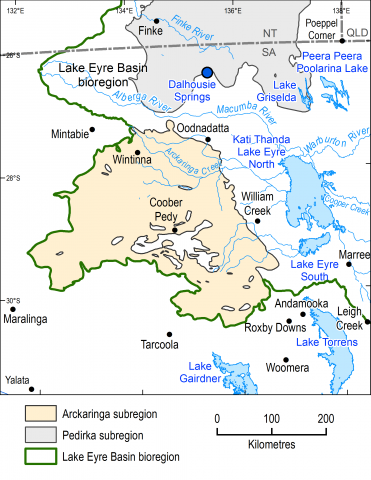- Home
- Factsheets
- Coal resource development and water resources in the Arckaringa subregion

At a glance
There is very low potential for coal resource development in the Arckaringa subregion. Exploration for coal and coal seam gas is at an early stage. Although coal resources are present, it is unlikely that there will be development that would affect water resources or water-dependent assets in the foreseeable future. The research shows a potential connection between the Arckaringa Basin and the overlying Great Artesian Basin.
What are the coal and coal seam gas resources?
There is coal in the rocks of the Arckaringa Basin, but as of July 2015, when this assessment was completed, there were no coal mines or commercial coal seam gas fields operating in the subregion. There is exploration underway for both conventional and unconventional gas.
Most of the coal is in older geological formations beneath the Great Artesian Basin, at depths that are uneconomic to mine using existing technologies. Together with the lack of existing infrastructure, this means coal mining is unlikely in the foreseeable future.
The coal seams in this subregion have not been buried deep and long enough to generate significant volumes of coal seam gas, making commercial production unlikely in the foreseeable future.
What did the assessment find?
The assessment developed the first hydrogeological (groundwater and geology) map of the Arckaringa Basin and mapped the extent of coal measures to a new level of detail.
New field research showed possible connection between parts of the Arckaringa Basin and the overlying Great Artesian Basin. Any open-cut mine would need to dig through the Great Artesian Basin to access the coal seams. This would likely result in impacts on groundwater systems in the Great Artesian Basin.
A modelled mine dewatering scenario in the Arckaringa Basin showed that impacts on the nationally important Witjira-Dalhousie Springs complex are highly unlikely.
The assessment also found that the Arckaringa Basin is structurally complex and that most of this complexity stems from past glacial activity rather than from faulting structures. Further, the deep hydrogeological systems are isolated from the regional flow system and not affected by modern recharge.
How was the assessment done?
Scientists used the best available data to describe coal and coal seam gas resources, surface water and groundwater resources. Local experts, including Natural Resources SA Arid Lands, local councils and community groups, provided information on water-dependent assets, such as wetlands and bores that rely on surface water or groundwater. A register of these assets is available for use in future assessments.
The scientific findings of three projects undertaken by the South Australian government as part of the Bioregional Assessment Program informed this assessment. These projects (Lake Eyre Basin Rivers Monitoring Project, Arckaringa Basin and Pedirka Basin Groundwater Assessment and Lake Eyre Basin Springs Assessment) investigated surface water and groundwater in the coal basins within the Lake Eyre Basin bioregion, including the Arckaringa subregion.
How will information from the assessment be used?
The data and tools from this assessment are available to support natural resource management in the Arckaringa subregion. Existing and newly acquired data on the characteristics of springs was formatted consistently so that datasets are more easily comparable across state boundaries. Information from the assessment can be used in future assessments and environmental studies.
Results from this assessment are provided in a contextual report, a water-dependent asset register and a data register at www.bioregionalassessments.gov.au/assessments/arckaringa-subregion. The website includes links to work by the South Australian government as part of the Bioregional Assessment Program. It also provides open access to the methods and datasets used to develop the assessment. Data from a range of disciplines are provided under a Creative Commons Attribution license where possible on the Australian Government's public data information service www.data.gov.au.

Where is the Arckaringa subregion?
The Arckaringa subregion is in South Australia and is one of four subregions within the Lake Eyre Basin bioregion. The Arckaringa subregion is defined by the known extent of the geological Arckaringa Basin, which is mostly buried deep below younger rocks such as those of the Great Artesian Basin.
